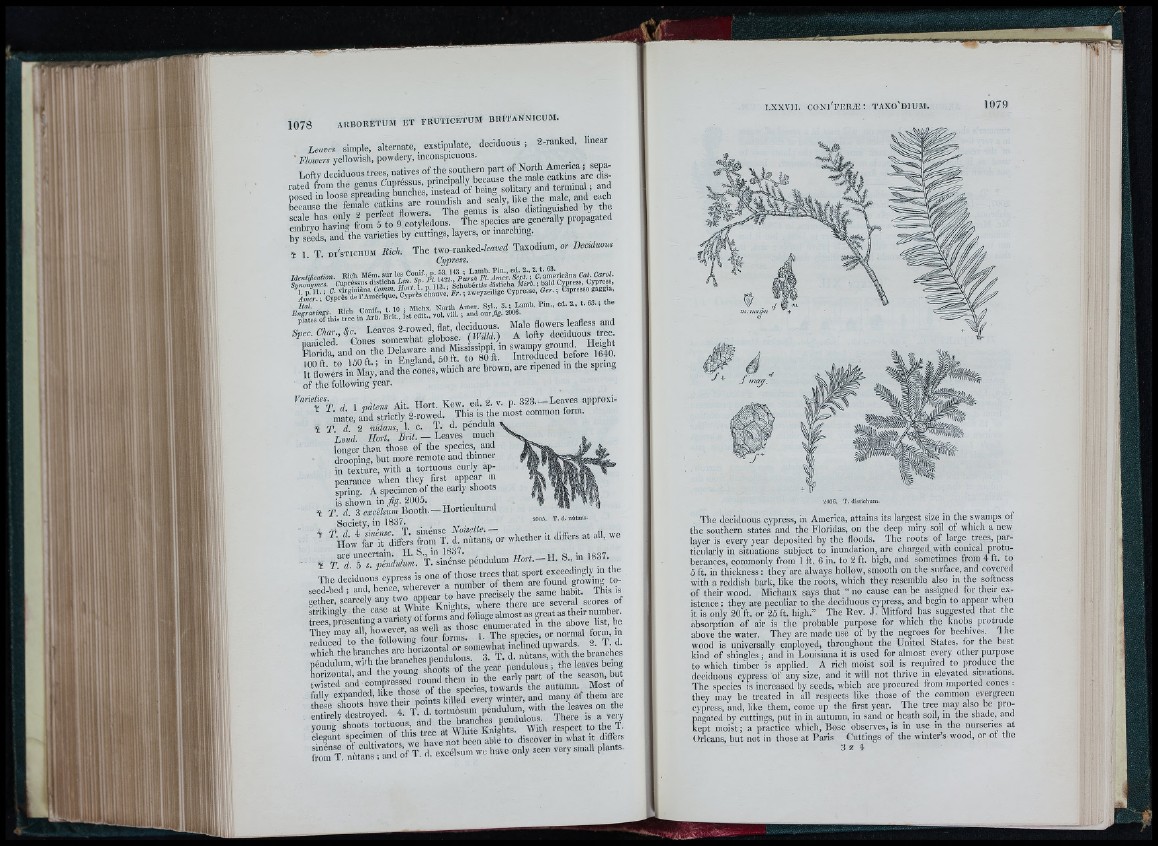
Lcavcs simple, alternate, exstipulate, deciduous ; 2-ranked, lineal-
eas, auu luv. »«a*-.-.— •»
T. Di'sTicnuM Rich. The two-ranked-W Taxodium, or Deciduous
2 t. 63.
C. americàna Cat. Carol.
' Flowers yellowish, powdery, inconspicuous.
Lcause ‘fo® ^ ? ? f l £ e r s . The genus is also distinguished by the
: ? t r y Y h a v t ! froiYs to 9 cotyledons. The spedes are generally propagated
by s e ? s , and the varieties by cuttings, layers, or marching. ^
Î 1.
Jdenlficalion. Rich. M«™',?” ¡
- Rich Comf t 10 ; Michx. North Amer. S y h S j Lamb. Pm., ed .2 ., t. 63.1 the
Engravings. Rich Lorn ., t , o u r /g . 2006.
s f r t j i r u « s 2 t . - „ t
K . r . . X ; £ S i . « * •
of the following year.
d 1 pàtens Ait. llo rt. Kew. ed. 2. v. p. 32.3.-L e a v e s approxi-
ma’te, a ? strictly 2-roweffi This is the mo,st common form.
Ï T d. 2 niitans, 1. c. I . d. pendula
Loud. Hort. Brit. — Leaves much
longer than those of the species, and
drooping, but more remote and thinner
in texture, with a tortuous curly appearance
when they first appear in
spring. A specimen ol the early shoots
is shown in Jig. 2005. u - i
¥ 'P d 3 excekuni'Qootb. — Horticultural
£ , • 1Q Q 7 2005. T . i l . nù tan s. Society, in , r • a.
^ d i ¿ ? ? ? T . “ s, or whether it differs at all, we
Ï / ' I " i u S ; péndiilum H o r t . - l l . 8. in 1837.
gether, scarcely any u. where tL r e are several scores of
péndulum with f ? t'he y j - p ^ H e leaves being
horizontal, and the youn„ ¿ ^ „ f ,he season, but
twisted “ 7 r e® r e ? ; ° "Y h Y s p e d e s to ^ autumn. Most of
fully ® yP™£?foY.i,eirnoints killed every winter, and many of them are
there shoots h » « „Indulum, with the leaves on the
entirely destroyed. 4. I . d. tortuosum There is a verv
200C. T . distichum.
The deciduous cypress, in America, attains its largest size in the swamps of
the xsouthern states and the Floridas, on the deep miry soil of which a new
layer is every year deposited by the floods. The roots of large trees, particularly
in situations subject to inundation, are charged with conical protuberances,
commonly from 1 ft. 6 in. to 2 ft. high, and sometimes from 4 ft. to
5 it. in thickness: they are always hollow, smooth on the surface, and covered
with a reddish bark, like the roots, which they resemble also m the softness
of their wood. Michaux says that “ no cause can be assigned ior their existence:
they are peculiar to the deciduous cypress, and begin to appear when
it is only 20 ft. or 25 ft. high.” The Rev. J. Mitford has suggested that the
absorption of air is the probable purpose for which the knobs protrude
above the water. They are made use of by the negroes for beehives. 1 he
wood is universally employed, throughout the United States, tor the best
kind of shingles ; and in Louisiana it is used for almost every other purpose
to which timber is applied. A rich moist soil is required to produce the
deciduous cypress of any size, and it will not thrive in elevated situations.
The species is increased by seeds, which are procured from imported cones :
they may be treated in all respects like those of the common evergreen
cypress, and, like them, come up the first year. The tree may also be propagated
by cuttings, put in in autumn, in sand or heath soil, in the shade, and
kept moist; a practice which, Bosc observes, is in use in the nurseries at
■ ut not in those at Paris Cuttings of the winter’s wood, or ot the
3 7 . 4
Orleans, but i